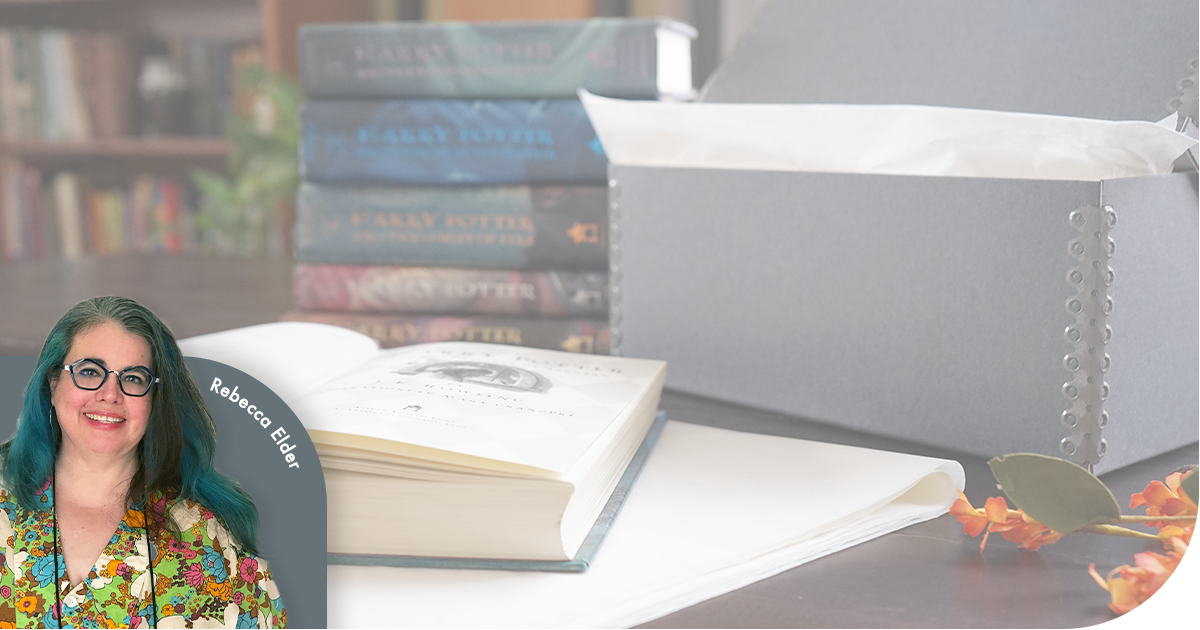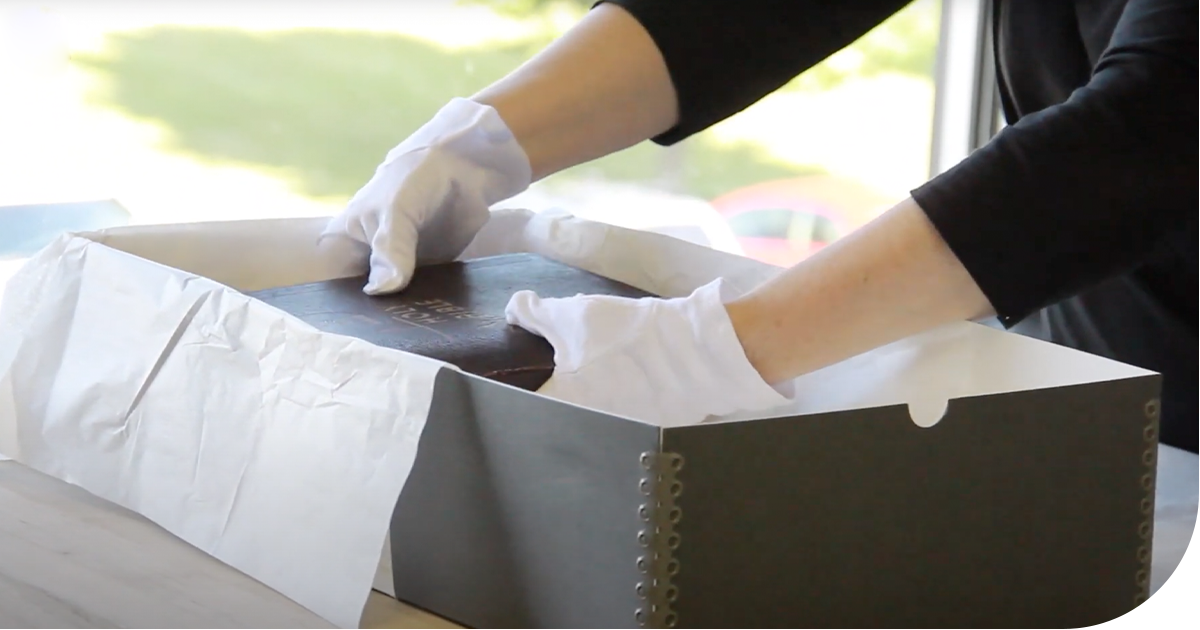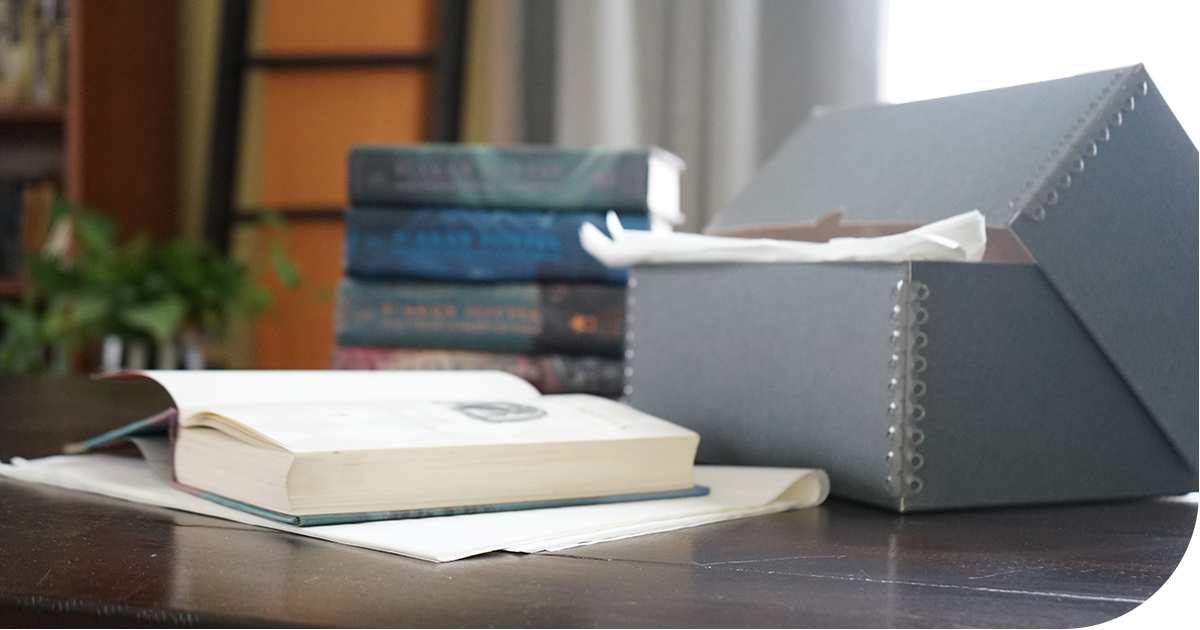Section 4: Introduction to Book Repair
Guide to Collections Care
Introduction
Books are meant to be handled, but their very use causes damage from wear and tear. Poor storage conditions and acidic paper also contribute to their deterioration. Even new publications printed on acid-free paper fall apart because of poor quality adhesive bindings. Misguided repair has also damaged books. Stiff repair tapes, yellowed cellophane tapes, over-trimming and poor rebinding have all destroyed original paper and bindings. For libraries, shrinking budgets for replacement and increased demand for access brought on by use of online catalogs only compound the problem. Fortunately, alternatives now exist.
The goal of this section is to provide background information for those about to begin or improve the repair of their book collections. Although it is oriented toward librarians setting up basic repair programs, others will also find it useful. Collectors and private individuals need the same basic tools, supplies, equipment, and manuals—even if working on a small scale.
The treatment of rare books, leather bindings, and special collections material is outside the scope of this section. It is advisable to consult a professional bookbinder or book conservator if your collections include these materials. The American Institute for Conservation (culturalheritage.org) provides a free referral service to conservators in your area.
The information in this section reflects our current knowledge regarding the setup of a book repair program. It will be revised as new information and products become available.
Defining Book Repair
Book repair is remedial. It corrects damage that has occurred because of poor manufacture, use, abuse, and/or aging. For the purposes of this publication, we are restricting its definition to the repair of bindings and textblocks of modern books in general collections. These are typically case bindings* with covers made of cloth or paper over boards.
PARTS OF A BOOK
A typical case bound book has two components:
- The Case, made up of front and back boards (covers) and a stiff spine liner (spine inlay), covered by cloth or sturdy paper.
- The Textblock (contents), made up of pages sewn or glued together. A folded sheet of paper (endpaper) is glued to the shoulder of the first and last page of the textblock. The spine is lined with an open weave cloth (super) that extends onto the endpapers. The spine is strengthened further with a paper lining. The textblock is attached to the case by gluing the endpaper and super to the boards. The spine inlay is not glued to the spine lining of the textblock. This creates a hollow that allows the binding to flex and open easily. The hinge area (called the joint on the outside of the case) takes most of the strain of use and is typically the first area to show signs of damage.
TYPES OF BOOK DAMAGE
Damage occurs most often in three areas: the textblock (torn or soiled pages, detached pages, missing pages), the case (warped, soiled or abraded covers; torn headcaps, detached spines), and the attachment of textblock to the case (loose hinges, broken hinges, detached covers). One book can have several types of damage.
SELECTING CANDIDATES FOR REPAIR
Book repair should be an integral part of library operations. To make decision-making as efficient as possible, establish routines for sorting and evaluating damaged books. The following are general guidelines. Each library will set its own criteria and assign staffing responsibilities. Collectors will also benefit from seeing the scope—and limitations—of book repair. Many of the general principles outlined below apply when selecting books for purchase or for repair.
Catch damage early. Work with staff to identify volumes with minor damage such as loose pages or loose hinges before they become major problems. It takes less time and money to do a minor repair than a more extensive repair. Encourage patrons to note damage when an item is returned rather than do it themselves. "Homemade" repairs are usually damaging and difficult to reverse.
Sort damaged books into categories:
- Books to be repaired—Volumes with torn or loose pages, worn spines and covers, loose hinges, detached covers, or other minor damage. The paper should be flexible and not brittle.
- Books to be rebound by the library binder—Volumes with a larger number of detached pages, badly damaged covers, and major damage that cannot be repaired in the library. The selection of books for rebinding depends upon local factors such as budget and the importance of the book to the collection. Only books with flexible paper can be rebound.
- Books to be replaced or reformatted—Volumes that are brittle, yellowed, or have extensive losses. Depending upon library policy and availability, these may be replaced with a new copy, reprint, microfilm, or preservation photocopy.
- Books to be discarded—Volumes that do not warrant the time or expense to repair or rebind. These may include books with missing pages, out-of-date information, or lack of relevance to the collection.
- Books to be reviewed for conservation or boxing—If a volume has historic, monetary, or artifactual value, set it aside for treatment by a conservator or hand bookbinder. Some libraries have established a date cut-off—1900 for example—for review by a bibliographer before treatment. It is better to box or wrap a valuable volume than treat it incorrectly. See Section 1, Case Study VII, for further information on storage of rare books and bound materials.
Batch candidates for repair. Once the damaged books have been identified, sort them into the categories of repair.
Select repair materials that are chemically stable and non-damaging. Avoid materials such as acidic papers and book repair tapes. For examples of acceptable materials, see the Supplies section.
Use techniques that are structurally sound. Consult the manuals on page 60 and obtain training to execute repairs that will contribute to the long-term stability and preservation of your collection.
Work systematically. Most manuals recommend working on 5–10 volumes at a time for maximum efficiency. Precutting supplies will expedite this process. Examine the textblock and do any paper mends before proceeding to the binding.
Maintain quality control. Work should be neat, accurate, and sound. Book repair is no place for sloppy craftsmanship. When new staff are assigned to repair, they should be trained by an experienced person and given manuals for reference. Their work should be reviewed periodically to be certain they understand both principles and techniques of book repair.

Setting up a workspace
If you anticipate doing repair on a regular basis, set aside a designated area with ample space for both work and storage. This space should provide access to a sink, adequate ventilation, and good lighting. Before investing in large equipment such as a cutter or presses, you should have a clear idea of the type of work that you will be doing, both now and in the future. Visit other workshops that have comparable programs.
Workbench or Tables
Each person should have a workbench equivalent to the size of a large desk (21/2 x 6 ft.). The best height is between 36 and 40 inches so that the person can work comfortably while standing. Low-cost alternatives are a work table raised on wooden blocks, provided the table is sturdy and stable. The work surface should be easy to clean; formica or a wood surface treated with polyurethane are good choices. It is convenient to have a set of shelves beneath the bench to hold paper and other materials.
Stools or Chairs
Stools or chairs should be available for each worker. They should be 6-12" lower than the bench. Wooden stools are the least expensive alternative, but you may want to purchase a cushioned chair with back support if the person is to work for long periods of time.
Lighting
Good lighting is essential for doing book repair. A high intensity lamp provides task lighting to supplement overhead lighting. Be sure to purchase a model that uses a minimum of 100 watts to give strong lighting.
Storage
You will need storage for repair materials and supplies. Itemize the amounts and sizes of paper, board, and cloth that you will be using and plan accordingly. Open metal shelving is an inexpensive alter-native, but you may want to use flat files (map cases) to protect sheets of Japanese paper or endpaper stock. Peg boards, jars, shelves, containers can all be used to keep tools close at hand. The manuals by Greenfield and Lavender (page 60) contain good illustrations of workbenches and storage units.
Selecting Tools, Equipment & SUpplies
SMALL TOOLS
The following tools are recommended for general use in book repair. You may need additional tools for specialized treatments. You will find these listed in the manuals that describe the treatments.
Awl: small, sharp tool; used for making holes when sewing in pamphlet bindings or preparing end-papers and signatures for sewing.
Bone Folder: smooth, flat tool with rounded or pointed ends; used to crease paper, to rub down paper and cloth after gluing, and to set the joints when repairing bindings.
Brushes:
- Glue brushes—round bristle glue brushes for applying adhesive to broad areas.
- Small artist's brushes—for mending paper and hinging, applying adhesive in small places.
- Dusting brush—to clean off work surfaces.
Containers: sturdy plastic containers in a range of sizes to hold tools, water; with lids to hold small quantities of adhesives
Cutting Tools:
- Scalpel, mat knife or other cutting implements—for trimming paper or cutting materials. Have extra blades on hand. A dull cutting tool can be dangerous and difficult to use.
- Utility knife—useful for cleaning the backs of spines.
- Self-healing Cutting Mat—provides a grid surface for cutting paper; particularly useful trimming endpapers on the book where you cannot use a paper cutter. Does not dull the blades of cut-ting implements.
Hammer: a special bookbinder's hammer, used with a backing press to shape the spines of the textblock prior to binding.
Microspatula: a useful tool for lifting tape and getting adhesive into narrow places.
Needles: large eyed needles (No. 3 darning needle or No. 6 crewel needles are useful sizes) for sewing pamphlets into binders and for sewing signatures.
Press Boards: wooden boards are needed for pressing material underweight. These may be hardwood, plywood, or tempered masonite, sanded and finished with polyurethane. Useful sizes are 9 x 12" and 6 x 9".
- Metal edged press boards—wooden boards with metal edges on the long side, projecting 1/16".
- Plexiglas rods or No. 4 or 5 knitting needles—for applying adhesive when tightening hinges or pressing hinges with boards.
Rulers and Straight Edges:
- Rulers—used for measuring.
- Metal straight edges—for cutting with scalpels or knives, and for scoring with a bone folder.
- T-Squares and Triangles—for cutting materials where right angles are required.
Shears: good quality, accurate shears and scissors in a range of sizes are essential.
- Heavy shears for cutting lightweight board and cloth.
- Medium sized scissors for cutting paper.
- Smaller scissors for reaching narrow spaces.
Tacking Iron: small, light-weight iron, thermostatically controlled; used to apply heat-set tissue or dry mends.
Weights:
- Bricks wrapped in heavy paper or binders cloth.
- Bean bags or leather/cloth weights filled with shot.
- Jars filled with shot or pennies, paperweights.
- Plexiglas covered lead weights.
LARGER EQUIPMENT
Book Presses: One of the guiding principles of book repair is to get good adhesion between the hinge of the textblock and the joint of the case. If budgets are limited, you may begin with boards, bricks, and knitting needles or Plexiglas rods. However, metal-edged boards are a more efficient and effective way of setting the joints. They may be used with weights or with book presses. If you rebind large numbers of books, a heavy metal book press and press boards will improve the quality and efficiency of your work.
Casing Press: As repair operations expand, you may want to add Gaylord's casing press. The press itself can be attached to the workbench and used as a book press to set the joints of bindings after repair. Assembled in its stand with beveled boards, it becomes a backing press, a versatile machine for holding the textblock when cleaning or backing/ reshaping spines, or doing finish work.
Board Shear or Heavy-duty Cutter: A cutting mat and a sharp table model paper cutter will be adequate for simple mending and repair. However, if you want to do rebinding or make boxes—which requires frequent cutting of heavy board—you will need a heavy cutter. A board shear, or heavy-duty cutter, is a major financial investment and requires substantial space in the workshop. However, it is also one of your most important purchases because a sharp, accurate cutter will improve the quality and speed of work. It is important that the cutter be able to cut board and paper; that the blade be long enough to cut most common lengths of materials; that it have a clamping bar to hold materials being cut; and have scales for accurate measuring. Board shears are best for a professional bindery. Heavy-duty table models can cut lightweight board and are less expensive than floor models. Gaylord carries book presses and a heavy-duty table model cutter. For vendors of board shears, large presses, and other heavy bookbinding equipment, consult the Supplies Directory of the Guild of Book Workers (Section 5, Resources). It is sometimes possible to find used equipment advertised in the Newsletter of the Guild of Book Workers.
SUPPLIES
The choice of materials for repair is critical. They should be acid-free, chemically stable, and durable. Labor is the most expensive cost of repair so it is not cost effective to save money on supplies if it results in repairs that fall apart because of stiff, brittle adhesives or papers and tapes that turn yellow and stain. The following are the most common supplies used in basic book and paper repair. You may find more specialized supplies listed in manuals that describe specific treatments.
Adhesives: used to bond paper, board, cloth, and the book together during repair. Three types of adhesives are commonly used: starch paste and methylcellulose for paper repair because of their reversibility, and PVA for binding repair because of its flexibility and strength.
- Starch Paste—Wheat starch makes a smooth, strong paste. It is made by cooking, though a pre-cooked wheat paste is also available. Both have a limited shelf life after preparation.
- Methylcellulose—Methylcellulose is easily made by mixing powder with water. When paper repair is not done often, it is a good alternative to starch paste because it has a long shelf life.
- PVA adhesive—Polyvinyl acetate is a white synthetic resin that dries to a thin, clear, flexible film. It is water-based and is used in book-binding where reversibility is not important.
Board: Several kinds of board are used when doing book repair. Its thickness is measured in points, which correspond to mils or thousandths of an inch. For example, the blue/grey barrier board used for phase boxes is 60-pts. or .060 inches thick. Board should be acid-free. Be certain that your cutter can handle the size and thickness of the board that you choose.
- Lightweight folder stock—7-pt. folder stock is used for spine inlays and map pockets in the backs of books.
- Folder stock—10-pt. and 20-pt. folder stock makes lightweight folders and enclosures, while 40-pt. stock is used for enclosures. 60-pt. stock can be used for the covers of pamphlet binders and phase boxes.
- Binders board—Gray Davey Board is the traditional board used by binders. An acid-free version is now available in thicknesses from .067 for small books and .082 for standard sized books to .098 for large books.
Cloth:
- Cambric—A closely woven white, starch-filled linen cloth used for hinges and spine linings.
- Super—A loosely woven cloth used to line the backs of spines.
- Bookcloth—A generic term for the woven materials used to cover the case of books. It is typically made of cotton with starch and pigment fillers and an acrylic surface coating. Gaylord carries four colors in convenient 2", 3" and 4" rolls for book repair. These cloths, along with a wide range of linens and fine paper-backed cloths, are available by the yard from vendors specializing in bookbinding supplies (see the Guild of Book Workers Supply Directory, page 56) The finer cloths are not appropriate for circulating library books because they become soiled easily.
Erasers:
- Vinyl erasers such as Magic Rub and Mars Staedtler erasers are recommended because they leave less residue on the paper.
- Document cleaning pads of powdered eraser are even gentler.
Papers:
- Endpaper stock—Papers selected for endpapers should be acid-free, buffered, and durable. Several colors are desirable: white for modern books, cream or beige to match the texts of older books. If precut sheets are available, select a size that fits your cutter blade.
- Japanese paper—Traditional handmade Japanese papers are excellent for repair because their long fibers provide a strong, yet flexible join. They come in a range of shades and weights. Libraries typically use medium weight for guarding signatures and lightweight for mending paper.
- Heat-set tissue—This fine paper is coated on one side with an acrylic adhesive that adheres when heat is applied with a tacking iron. Heat-set tissue is used for mending tears and consolidating shattered edges of paper, especially for moisture-sensitive paper that cannot withstand the application of a wet paste.
Other papers are also needed for repair operations:
- Blotting paper—for drying and flattening paper
- Silicone release paper—for use with a tacking iron when applying heat-set tissue.
- Scrap paper—for all operations. Avoid fresh newsprint or any other paper with printing or writing that may offset onto your work.
- Wax paper—as a barrier prevents adhesive from sticking to adjacent surfaces while work dries. Gaylord makes a special wax paper for book repair.
Tape: Although the range of tapes has increased dramatically with the development of synthetic materials and more stable acrylic adhesives, it is best to consider all tapes to be permanent. Once applied, tape is difficult or impossible to remove. Filmoplast tapes are considered acceptable for some types of paper repair. Filmoplast P (TP) has a lightweight, acid-free paper carrier with a stable adhesive. However, even it should not be used on rare books, documents, or archival materials with artifactual value. Some research libraries use Japanese paper and starch paste for nearly all their paper mending, even on circulating collections. However, this requires a trained staff.
Thread: High quality linen thread should be used for sewing because of its strength. Medium weight is the most versatile, while heavier weight thread is used to sew pamphlets.

Gaylord Archival® Guide to Collections Care
-
Archival Storage of Paper >
-
Archival Storage of Photographic Materials >
-
Archival Storage of Textiles >
-
An Introduction to Book Repair >
FREE copies of the Guide to Collections Care are available.




